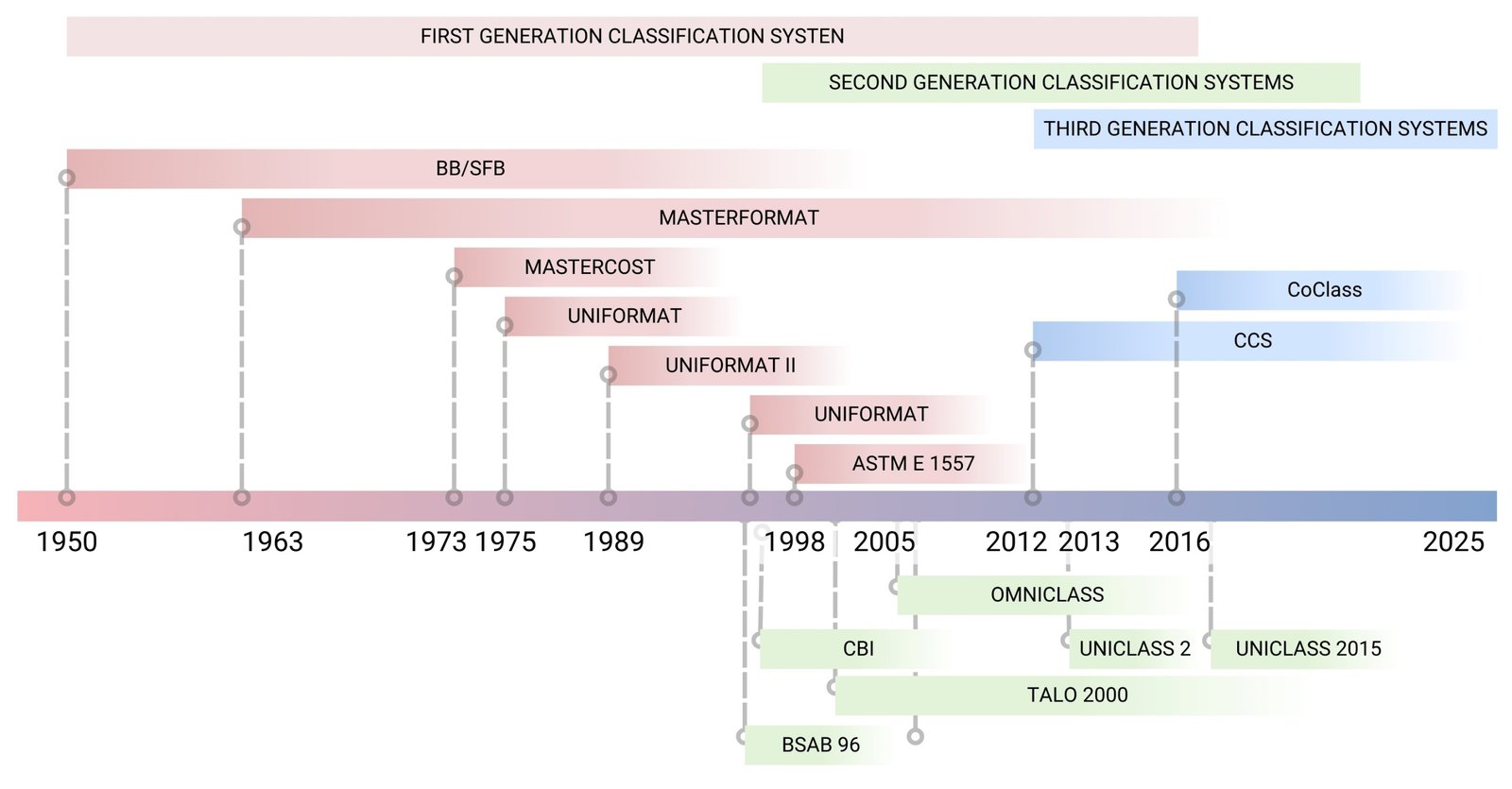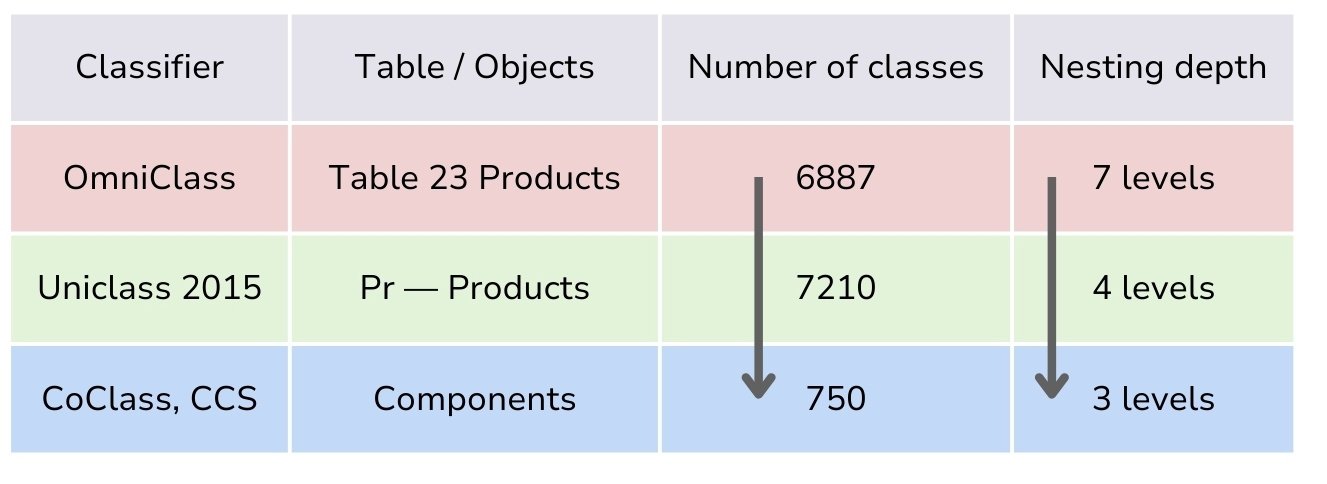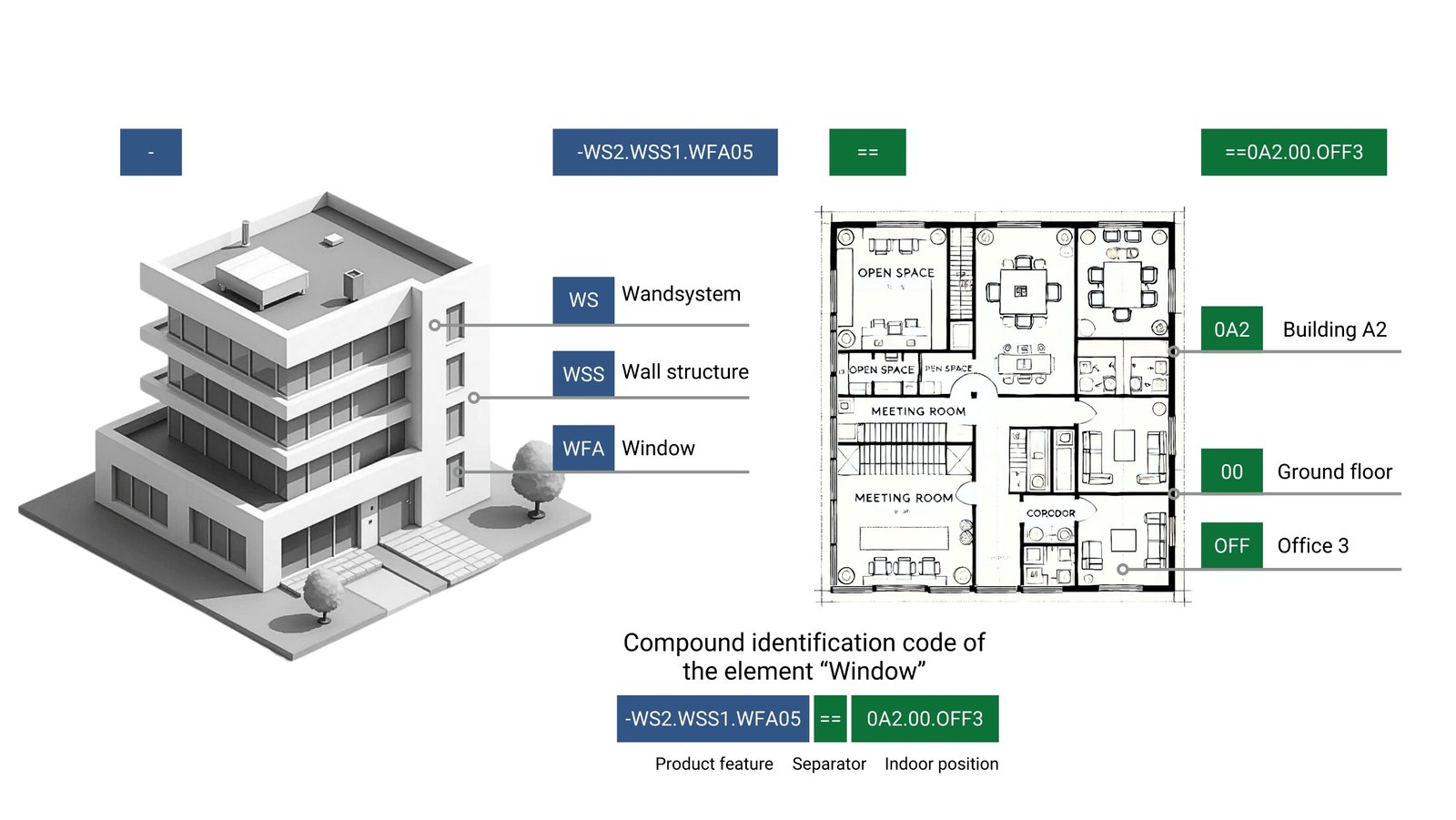Historically, construction element and work classifiers have evolved in three generations, each reflecting the level of available technology and the current needs of the industry in a particular time period (Fig. 4.2-8):
- First generation (early 1950s to late 1980s) – paper-based directories, hierarchical classifiers used locally (e.g. Masterformat, SfB).
- The second generation (late 1990s to mid-2010s) are spreadsheets and structured databases implemented in Excel and Access (ASTM E 1557, OmniClass, Uniclass 1997).
- Third generation (2010s to present) – digital services and APIs -interfaces, integration with CAD (BIM), automation (Uniclass 2015, CoClass).

Over the last decades there has been a reduction in the hierarchical complexity (Fig. 4.2-9) of classifiers: while early systems such as OmniClass, used up to 7 nesting levels to describe 6887 classes, modern solutions such as CoClass are limited to 3 levels with 750 classes. This simplifies data handling while maintaining the necessary granularity. Uniclass 2015, often used as a standard in the UK, combines 7210 classes in just 4 levels, making it convenient for CAD projects and public procurement.

In the construction estimating systems of different countries, even a typical element such as a concrete foundation wall can be described in very different ways due to different classifications (Fig. 4.2-10). These differences reflect national construction practices, measurement systems used, approaches to material classification, and the regulatory and technical requirements in force in each country.

The diversity of classifications of the same elements complicates international cooperation, makes the comparison of cost and scope of work within international projects laborious and sometimes almost impossible. At the moment, there is no one universal classifier at the global level – each country or region develops its own systems based on local norms, language and business culture:
CCS (Denmark): Cost Classification System – a classification system costs throughout the life cycle of a facility (design, construction, operation). The focus is on the O&M logic, but also includes budget and resource management.
NS 3451 (Norway): categorizes facilities by function, design elements and life cycle stages. Used for project management, cost estimation and long-term planning.
MasterFormat (USA): a system for structuring construction specifications into sections (e.g. concrete, electrical, finishing). Focus on disciplines and work types rather than functional elements (unlike UniFormat).
Uniclass 2 (UK): one of the most detailed classifiers, used in public procurement and BIM – projects. Unifies data on objects, works, materials and spaces into a single system.
OmniClass: an international standard (developed by CSI in the USA) for managing object information, from component libraries to electronic specifications. Suitable for long-term data storage, compatible with CAD (BIM) and other digital tools.
COBie: Construction-Operation Building information exchange is an international standard for the exchange of data between the design, construction and operation phases. Included in BS 1192-4:2014 as part of the concept of “BIM -model ready for operation”. Focuses on information transfer (e.g. equipment specifications, warranties, contractor contacts).
The globalization of the construction industry is likely to lead to a gradual unification of building element classification systems, which will significantly reduce dependence on local national standards. This process may develop similarly to the evolution of Internet communications, where universal data transfer protocols eventually supplanted disparate local formats, ensuring global interoperability of systems.
An alternative development path may be a direct transition to automatic classification systems based on machine learning technologies. These technologies, which are being developed today mainly in the field of autonomous transportation, have significant potential for application to large CAD design data sets (Fig. 10.1-6).
Today the situation is not limited only to the national clustering of classifiers. Due to the many peculiarities not taken into account at the national level, each company has to independently engage in unification and standardization of the categories of elements and resources with which it works.
As a rule, this process starts small – with local tables of objects or internal designation systems. However, the strategic goal is to move to a common language for describing all elements, which would be understandable not only within the company, but also outside it – ideally, harmonized with international or industry classifiers (Fig. 4.2-8). This approach facilitates integration with external partners, digital systems and promotes the formation of unified end-to-end processes within the life cycle of objects.
Before moving to automation and scalable IT systems, it is necessary to either use national-level classifiers or build your own, logical and unambiguous element identification structure. Every object – whether it is a window (Fig. 4.2-11), a door, or an engineering system – must be described in such a way that it can be unmistakably recognized in any company’s digital system. This is critical in the transition from flat drawings to digital models, covering both the design phase and building operation.

One example of internal classifiers could be the development of a composite identification code (Fig. 4.2-11). Such a code combines several levels of information: the functional purpose of the element (e.g., “window in the wall”), its type, and the exact spatial reference – building A2, floor 0, room 3. Such multilevel structure allows to create a unified system of navigation through digital models and documentation, especially at the stages of data verification and transformation, where unambiguous grouping of elements is required. Unambiguous element recognition ensures consistency between departments and reduces the risks of duplication, errors and loss of information.
A well-aligned classifier is not just a technical document, it is the foundation of a company’s digital ecosystem:
- ensures data compatibility between systems;
- reduces the cost of searching and processing information;
- increases transparency and manageability;
- Creates a foundation for scaling and automation.
Standardized description of objects, through the use of national classifiers or own composite identification codes becomes the basis for consistent data, reliable information exchange and subsequent implementation of intelligent services – from automated procurement to digital twins.
After completing the structuring stage of multi-format data and selecting a classifier to be used for recognizing and grouping elements, the next step is correct data modeling. This process involves identifying key parameters, building a logical data structure and describing the relationships between elements.






















